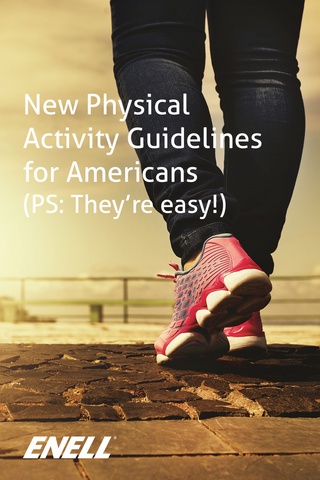Just Move: Simple Instructions in New Physical Activity Guidelines for Americans
Just move… anytime, anywhere, by any means.
Doing so, in any way, will dramatically improve health. That’s the message in the first new Physical Activity Guidelines for Americans published since 2008. The Department of Health and Human Services announced in mid-November an intensive 10-year review of available science about physical activity and made modifications on the original guidelines.
They had stressed doing 10 minute bouts of exercise a couple times each day of the week to achieve the substantial health benefits of an active lifestyle; however, now they say it all counts. Only 26% of men, 19% of women, and 20% of adolescents adhere to the previous guidelines, healthcare costs that rack up a $117 billion bill in the U.S. annually.
These new guidelines represent the latest scientific findings and introduce even more previously-unknown health benefits, all of which benefit the way we feel, function, and sleep.

HOW MUCH EXERCISE DO WE NEED?
Adults over age 17 should aim for 150 to 300 minutes (2.5 to 5 hours) of moderate-intensity exercise each week and 2 days of muscle-strengthening exercise. If you prefer more vigorous/high-intensity exercise, aim for 75 minutes each week. But again … all movement counts!
Kids age 6-17 should engage in 60 minutes of active exercise or play every day, including activities that develop bone strength like climbing, jumping rope, and basketball.
Preschool children age 3-5 should be moving through active play three hours a day.
WHAT ARE THE NEW FITNESS BENEFITS?
The biggest change from HHS advises everyone to “move more, sit less.” Contrary to popular opinion, sitting is not worse than smoking. But it’s not great for you either. Sedentary individuals are at a much higher risk of developing heart disease, high blood pressure, excessive weight gain, and all-cause mortality. They say any and all movement offsets these effects.
From a single bout of activity you will see immediate benefits in reduced anxiety, lower blood pressure, improved sleep, and lower insulin sensitivity.
Long-term activity benefits include brain health, reduction in risk for eight different cancers (previously HHS only listed two types), and reduced risk for fall-related injuries.
All of this movement and activity can also help manage chronic illnesses, including reduced progression of hypertension and type 2 diabetes, reduced anxiety and depression, ADHD relief, and decreased pain from osteoporosis.
WHAT COUNTS AS EXERCISE?
Everything! Walk the dog, dance, vacuum, garden, move boxes, chase your kids, take a swim, have sex… all movement counts! It’s an effective idea the authors of What You Can, When You Can came around to years ago.
These moderate-intensity yoga poses will really fire up your practice.
You can squeeze in this 7-minute workout just about anywhere.
Even these 21 light-intensity exercises will give you simple but worthwhile excuses to just get up and move.


